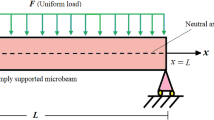Abstract
In the present work, the quality factor (and thermoelastic damping) of a microbeam resonator is analyzed by employing the three-phase-lag thermoelasticity theory with memory-dependent derivative. We compare our results with different heat conduction models. An explicit formula of thermoelastic damping has been derived, and effects of the normalized frequency and the beam height on thermoelastic damping of the microbeam resonator have been studied. We presented our work numerically by taking Silicon. The effects of normalized frequency, beam height, and different kernel of memory-dependent derivative on thermoelastic damping has been presented with the numerical data of Silicon.





Similar content being viewed by others
References
Mohanty, P., Harrington, D.A., Ekinci, K.L., Yang, Y.T., Murphy, M.J., Roukes, M.L.: Intrinsic dissipation in high-frequency micromechanical resonators. Phys. Rev. B—Condens. Matter Mater. Phys. 66, 085146 (2002). https://doi.org/10.1103/PhysRevB.66.085416
Reid, S., Cagnoli, G., Crooks, D.R.M., Hough, J., Murray, P., Rowan, S., Fejer, M.M.: Mechanical dissipation in silicon flexures. Phys. Lett. A 351, 205–211 (2006). https://doi.org/10.1016/j.physleta.2005.10.103
Biot, M.A.: Thermoelasticity and irreversible thermodynamics. J. Appl. Phys. 27, 240 (1956). https://doi.org/10.1063/1.1722351
Lord, H.W., Shulman, Y.: A generalized dynamical theory of thermoelasticity. J. Mech. Phys. Solids 15, 299–309 (1967). https://doi.org/10.1016/0022-5096(67)90024-5
Green, A.E., Lindsay, K.A.: Thermoelasticity. J. Elast. 2, 1–7 (1972)
Tzou, D.Y.: A unified field approach for heat conduction from macro- to micro-scales. J. Heat Transf. 117, 8–16 (1995). https://doi.org/10.1115/1.2822329
Tzou, D.Y.: The generalized lagging response in small-scale and high-rate heating. Int. J. Heat Mass Transf. 38, 3231–3240 (1995). https://doi.org/10.1016/0017-9310(95)00052-B
Tzou, D.Y.: Experimental support for the lagging behavior in heat propagation. J. Thermophys. Heat Transf. 9, 686–693 (1995). https://doi.org/10.2514/3.725
Green, A.E., Naghdi, P.M.: A re-examination of the basic postulates of thermomechanics. Proc. R. Soc. A Math. Phys. Eng. Sci. 432, 171–194 (1991). https://doi.org/10.1098/rspa.1991.0012
Green, A.E., Naghdi, P.M.: On undamped heat waves in an elastic solid. J. Therm. Stress 15, 253–264 (1992)
Green, A.E., Naghdi, P.M.: Thermoelasticity without energy dissipation. J. Elast. 31, 189–208 (1993). https://doi.org/10.1007/BF00044969
Choudhuri, S.K.R.: On a thermoelastic three-phase-lag model. J. Therm. Stress 30, 231–238 (2007). https://doi.org/10.1080/01495730601130919
Zener, C.: Internal friction in solids. I. Theory of internal friction in reeds. Phys. Rev. (1937). https://doi.org/10.1103/PhysRev.52.230
Zener, C.: Internal friction in solids II. General theory of thermoelastic internal friction. Phys. Rev. (1938). https://doi.org/10.1103/PhysRev.53.90
Kinra, V.K., Milligan, K.B.: A second-law analysis of thermoelastic damping. J. Appl. Mech. Trans. ASME 61, 71 (1994). https://doi.org/10.1115/1.2901424
Lifshitz, R., Roukes, M.: Thermoelastic damping in micro- and nanomechanical systems. Phys. Rev. B—Condens. Matter Mater. Phys. 61, 5600–5609 (2000). https://doi.org/10.1103/PhysRevB.61.5600
Vahdat, A.S., Rezazadeh, G., Ahmadi, G.: Thermoelastic damping in a micro-beam resonator tunable with piezoelectric layers. Acta Mech. Solida Sin. (2012). https://doi.org/10.1016/S0894-9166(12)60008-1
Zuo, W., Li, P., Zhang, J., Fang, Y.: Analytical modeling of thermoelastic damping in bilayered microplate resonators. Int. J. Mech. Sci. (2016). https://doi.org/10.1016/j.ijmecsci.2015.12.009
Zenkour, A.M.: Nonlocal thermoelasticity theory without energy dissipation for nano-machined beam resonators subjected to various boundary conditions. Microsyst. Technol. 23, 55–65 (2017). https://doi.org/10.1007/s00542-015-2703-4
Kumar, R., Kumar, R., Kumar, H.: Effects of phase-lag on thermoelastic damping in micromechanical resonators. J. Therm. Stress. (2018). https://doi.org/10.1080/01495739.2018.1469061
Ezzat, M.A.: Fundamental solution in generalized magneto-thermoelasticity with two relaxation times for perfect conductor cylindrical region. Int. J. Eng. Sci. 42, 1503–1519 (2004)
Ezzat, M.A., Awad, E.S.: Constitutive relations, uniqueness of solution, and thermal shock application in the linear theory of micropolar generalized thermoelasticity involving two temperatures. J. Therm. Stress. 33, 226–250 (2010)
El-Karamany, A.S., Ezzat, M.A.: On the three-phase-lag linear micropolar thermoelasticity theory. Eur. J. Mech.—A/Solids 40, 198–208 (2013)
El-Karamany, A.S., Ezzat, M.A.: On the dual-phase-lag thermoelasticity theory. Meccanica 49, 79–89 (2014)
Kaur, I., Lata, P., Singh, K.: Study of transversely isotropic nonlocal thermoelastic thin nano-beam resonators with multi-dual-phase-lag theory. Arch. Appl. Mech. 91, 1–25 (2020)
Wang, J.L., Li, H.F.: Surpassing the fractional derivative: concept of the memory-dependent derivative. Comput. Math. Appl. 62, 1562–1567 (2011). https://doi.org/10.1016/j.camwa.2011.04.028
Yu, Y.J., Hu, W., Tian, X.G.: A novel generalized thermoelasticity model based on memory-dependent derivative. Int. J. Eng. Sci. 81, 123–134 (2014). https://doi.org/10.1016/j.ijengsci.2014.04.014
Ezzat, M.A., El-Karamany, A.S., El-Bary, A.A.: Generalized thermo-viscoelasticity with memory-dependent derivatives. Int. J. Mech. Sci. 89, 470–475 (2014)
Ezzat, M.A., El-Bary, A.A.: Memory-dependent derivatives theory of thermo-viscoelasticity involving two-temperature. J. Mech. Sci. Technol. 29, 4273–4279 (2015)
Ezzat, M.A., El-Karamany, A.S., El-Bary, A.A.: Modeling of memory-dependent derivative in generalized thermoelasticity. Eur. Phys. J. Plus. 131, 372 (2016). https://doi.org/10.1140/epjp/i2016-16372-3
Ezzat, M.A., El Karamany, A.S., El-Bary, A.A.: Electro-thermoelasticity theory with memory-dependent derivative heat transfer. Int. J. Eng. Sci. 99, 22–38 (2016)
Al-jamel, A., Al-jamal, M.F., El-karamany, A.: A memory-dependent derivative model for damping in oscillatory systems. J. Vib. Control 24, 2221–2229 (2018). https://doi.org/10.1177/1077546316681907
Mondal, S., Sur, A., Kanoria, M.: A memory response in the vibration of a microscale beam induced by laser pulse. J. Therm. Stress (2019). https://doi.org/10.1080/01495739.2019.1629854
Mondal, S., Othman, M.I.A.: Memory dependent derivative effect on generalized piezo-thermoelastic medium under three theories. Waves Random Complex Media (2020). https://doi.org/10.1080/17455030.2020.1730480
Lata, P., Singh, S.: Thermomechanical interactions in a non local thermoelastic model with two temperature and memory dependent derivatives. Coupled Syst. Mech. 9, 397–410 (2020)
Kaur, I., Lata, P., Singh, K.: Memory-dependent derivative approach on magneto-thermoelastic transversely isotropic medium with two temperatures. Int. J. Mech. Mater. Eng. 15, 1–13 (2020)
Kumar, R., Tiwari, R., Kumar, R.: Significance of memory-dependent derivative approach for the analysis of thermoelastic damping in micromechanical resonators. Mech. Time-Depend. Mat. 8, 1–18 (2020)
Youssef, H.M., Alghamdi, N.A.: Thermoelastic damping in nanomechanical resonators based on two-temperature generalized thermoelasticity theory. J. Therm. Stress 38, 1347–1361 (2015). https://doi.org/10.1080/01495739.2015.1073541
Author information
Authors and Affiliations
Corresponding author
Ethics declarations
Conflict of interest
The author declares that there is no any conflict of interest.
Additional information
Publisher's Note
Springer Nature remains neutral with regard to jurisdictional claims in published maps and institutional affiliations.
Rights and permissions
About this article
Cite this article
Kumar, R. Analysis of the quality factor of micromechanical resonators using memory-dependent derivative under different models. Arch Appl Mech 91, 2735–2745 (2021). https://doi.org/10.1007/s00419-021-01920-6
Received:
Accepted:
Published:
Issue Date:
DOI: https://doi.org/10.1007/s00419-021-01920-6




